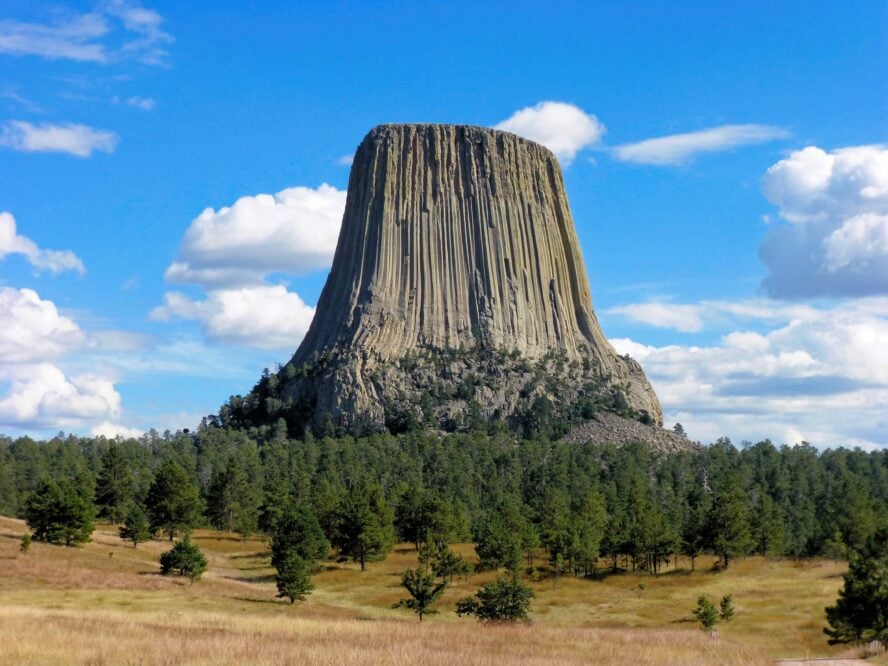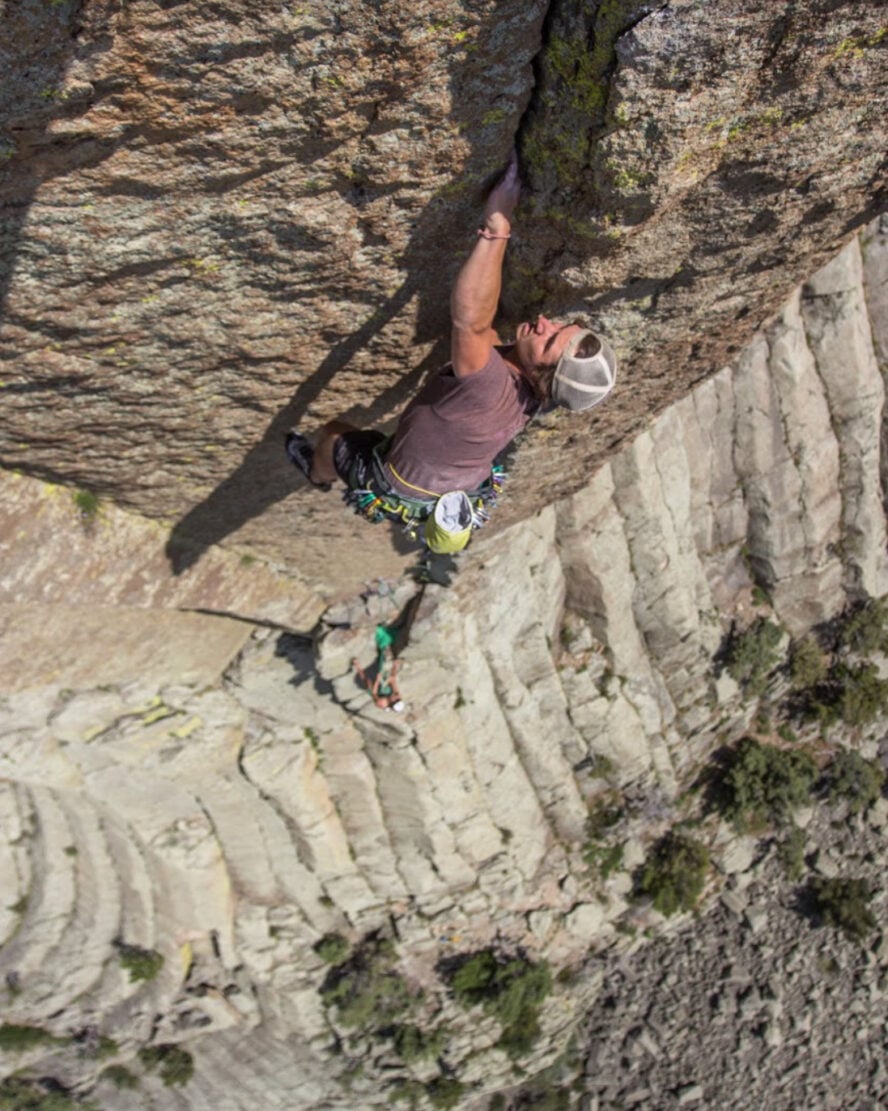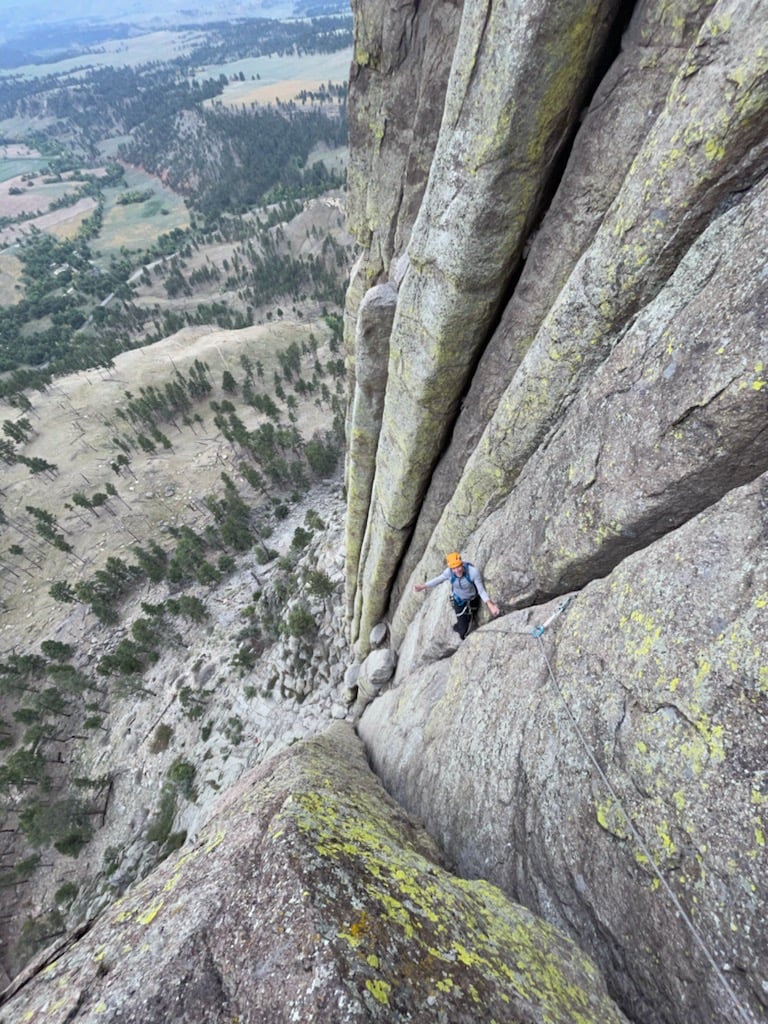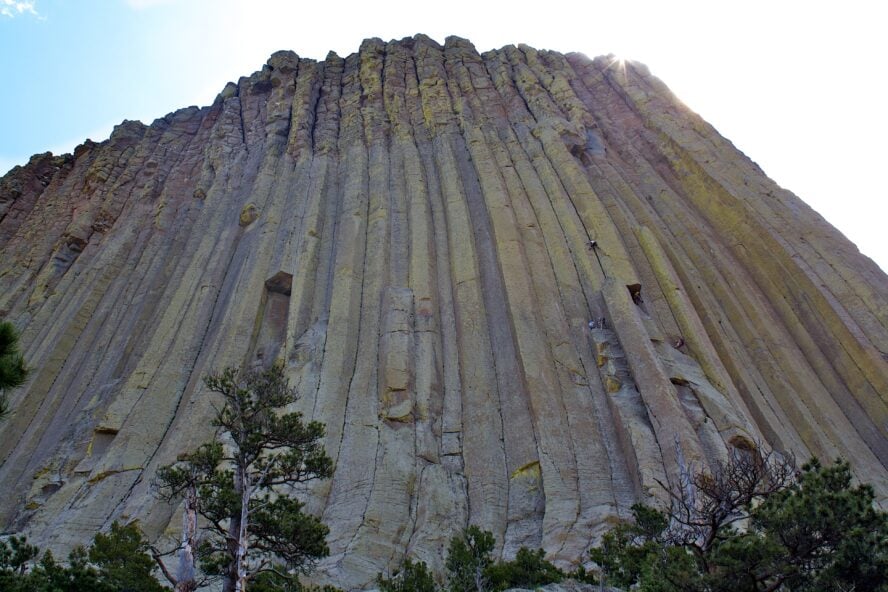I look down and find myself 15 feet above a number four cam. My limbs are awkwardly jammed into cracks on either side, every muscle slowly draining. Over the horizon the sun peeks out from behind an obscure cover and shines on the Durrance Route. It’s what I came for. One of North America’s “50 Classic Climbs” on one of the most eye-catching rock formations in the world: Devils Tower.
Dominating the horizon of one of the best states for rock climbing, his monstrous 867’ butte defies the sprawling Wyoming foothills. An obelisk wrapped with daunting splitters and sheer slabs, it ministers to the crowds about the sanctity of its 200+ routes. Every year, thousands of eager climbers flock to this alluring summit like migrating geese. Personally, I’ve opted to skip the transitory bit and stay right here because climbing Devils Tower is like nothing else. I want to share what makes this area so important to me, as well as the people who have lived here for millennia.

Pros and Cons of Climbing at Devils Tower
A Spirited History of Devils Tower
Climbing Devils Tower has consumed the minds of climbers for more than 100 years. The first recorded ascent was in 1893, when two local ranchers pulled themselves up on a ladder of wooden pegs driven into the cracks. It wasn’t until 1937, however, that Fritz Wiessner, placing just one piton on the whole route, made the first free ascent of Devils Tower. I can’t imagine what that would have been like, but I do know that the hundreds of challenging routes on it now make up some of the best crack climbs in the U.S.
Still, the history of the world precedes the Tower’s first ascents. 40.5 million years ago a flaring intrusion of magma breached the Earth’s sedimentary layers. As time ticked on the magma cooled and its casing eroded, revealing an arrangement of 5-, 6-, and 7-sided columns. The world weathered yet the phonolite plug remained, as if divined by a Great Spirit.
Native Americans at Devils Tower
The area may be a magnet for climbers, but to the local Native American people Devils Tower is much more significant. According to the Kiowa tribe, the tower was raised from the ground by the Great Spirit, or Wakan Tanka, to save a group of seven young girls from an enormous bear. The girls prayed to the Great Spirit who raised them so high that they became a cluster of seven stars—the Pleiades. As the bear clawed at the tower’s sides it scarred the stone with deep grooves leaving the unmistakable facade we see today.
Oral histories of the tower’s formation vary among tribes, including the Cheyenne, Lakota, and Crow, but the iconic peak is uncontestedly sacred to all. June marks the height of religious practices at the site, when members of over twenty tribes travel to perform sundances, sweat lodges, and prayer offerings. Since 1995, climbers have been expected to stay off of the sacred site for all of June, but between 200 and 500 climbers reportedly don’t respect the voluntary ban each year—another bruise in the long and strained history between White and Native cultures in the area.
In fact, it wasn’t until the arrival of European-Americans that the name “Devils Tower” was conceived. In 1875, the indigenous name “Bear’s Lodge” was reportedly misinterpreted by a caucasian translator as “Bad God’s Tower,” which eventually became the accepted name that most people know now. Despite multiple efforts to recognize the various Native American names (including “Aloft on a Rock,” “Tree Rock,” and “Great Gray Horn”), the party line that a name change would harm the tourist trade has kept “Devils Tower” in place.

Considerations for Climbing on Indigenous Lands
Devils Tower isn’t the only popular climbing destination in the western U.S. on Indigenous land. Another classic trad climbing area is Moab where conversations around ethical access of rock climbing and the importance of preservation of Native American culture, including petroglyphs and pictographs, have been steadily building for years.
In 2021, a climber from Colorado Springs bolted three routes on top of petroglyph panels dating from 2,000 to 700 years old. The incident erupted into a heated, albeit invaluable discussion about climbing access in such areas.
Perhaps THE best splitter crack climbing in the U.S., Indian Creek is also a culturally and spiritually sacred site to many Native Americans. Located an hour south of Moab, the protected area was reduced by 85% under the Trump administration in 2017. Just recently, the 1.9-million acre Bears Ears National Monument has been restored, but because of the current tenuous situation and longer, more complicated past, it’s important to inform yourself of the local etiquette and to be a responsible climber when you go to Bears Ears National Monument.
Through the lens of climbing at Devils Tower
Rock climbing at Devils Tower has opened my eyes to the history of the area and what it means to the people who have inhabited it for millenia. Now, when I’m heading to a new crag, or even visiting an old one, I always make sure that I’m up to speed on the expectations for climbers, whether that’s following state regulations or getting a gist of whose land I’m on and its history. As much as us climbers love the outdoors, it’s our responsibility to protect these areas and respect the people that use them.
This feels especially true as a Devils Tower local, having seen the tsunami of visitors flood in year after year. I grew up just a few hours east in Rapid City, and got my start climbing in Custer State Park, but it’s the Tower that I choose to call my home and where I’m proud to guide with my company, Sylvan Rocks. There’s a lot to love, which I’m always reminded of when jamming my way up the wall.

Climbing on Devils Tower is Like Crack Heaven
In the early mornings the first thing I see are anxious newcomers mummifying their hands in heaps of climbing tape. It may come as a surprise if you’re coming from the sharp rock of Vedauwoo or the Wind River Range, but the phonolite is so smooth there’s really no need for hand protection.
Don’t let the skin-friendly stone fool you though—the climbing itself is aggressive, with tons of cracks ranging from small fingers to offwidths that demand some serious technical skills. Some of my favorite climbing is on pin scars, pulling on two-finger locks pitch after pitch.
The iconic columns of Devils Tower form dihedral splitters that wrap all the way around, most just 5 to 10 feet apart. Where these columns top out before the peak, they offer a flat belay ledge—always a welcome break when I’m getting pumped. Some routes, namely El Matador, climb between two columns, forcing you into a wide stem for the entirety of the pitch. Of the few face pitches on Devils Tower, many are difficult slab climbs.
There’s a whole lot more than I’ll be able to climb in a lifetime, and the endless possibilities keep it fresh and exciting. Still, there are a few routes that have really stuck as my favorites.

My Favorite Climbing Routes on Devils Tower
1. Durrance Route: The Devils Tower climb
At 5.7, it’s the easiest way up and is one of the best rock climbing routes to summit Devils Tower. The multi-pitch shows some incredible variation, switching between hand cracks, offwidths, slabby faces, and a chimney over six pitches. The Durrance pitch—the second and hardest pitch— ascends a two-crack system for 50 feet before cutting to the offwidth on the right, where climbers face the crux of the route. Switching between crack sizes may come as a challenge for some, but the last thing you’ll be thinking is, “man, I wish I was on the ground, this sucks!”
At pitch 6, climbers can take Bailey’s Direct, a 5.4 crack that climbs directly to the summit, or the classic Jump Traverse, a 15’ traverse which includes an optional moment of suspension in midair. A 100 ft crack system takes you right to the top. After topping out, it isn’t hard to see how this route made its way into the “Fifty Classic Climbs of North America.”

2. Walt Bailey: Sustained jammin’
Walt Bailey (5.9) is pure and sustained, shooting 180 feet up a dihedral crack that widens towards the top. An early finger crack crux will test your skills, but you’ll be fighting the pump as you do jam after jam, switching from fingers to hands and eventually some wider sizes as well. The first fingers section is easily one of my favorite stretches of climbing in all of Devils Tower, creating perfect slits for ring locks, stacks, and finger jams. After topping out, climbers can choose to rappel down or head up a number of routes.
Fun fact about Devils Tower: In the 1980s, Todd Skinner, a local Wyoming hard man, free-soloed the Walt Bailey route in 18 minutes. It is the fastest the Tower has been climbed.
3. Assembly Line: A hand-jam jubilee
Assembly Line is two flawless pitches of hand and finger cracks, stretching up for 140 feet to the tower’s peak. A splitter hand crack that seems to continue on forever makes up the first three quarters of the climb, providing the perfect training ground and test piece for crack climbers. This is one of my favorite areas for guiding as well, as it offers the ability to lower into the Teacher’s Lounge, an area packed with hard cracks like Broken Tree and New Wave (5.10). When I’m looking for hand jams, Assembly Line and its neighbors are my go-to.
4. El Matador: The stem box of a lifetime
One of Devils Tower’s most picturesque routes, El matador (5.10d) consists of five unique pitches. Its second, the most iconic, is made up of two parallel walls over 150’ tall, creating an immaculate stem box. Even at 6’2”, I’m fully extended for some sections—but love it or hate it, this is definitely one of the most unique pieces of climbing you’ll find at Devils Tower. The next three pitches are a series of cracks and chimneys, ranging from 5.4 to a 5.10 crux move through a pumpy roof. This route has a great mix of grades, and you’ll top out feeling like you earned it.

5. One Way Sunset: An all-around winner
One Way Sunset is a great all-rounder that has everything you’re looking for in a Devils Tower climb. Starting off strong, a 5.10c finger crack ascends 90 feet before you hit a long technical crux, ending at the top of the first pitch another 60 feet up. From there, a 130’ 5.9 crack, hands and fist-width, makes up the second pitch, leading into three more crack pitches at 5.9 and below. The first two pitches set a high bar that the last three don’t quite live up to, so a lot of climbers will choose to rap down after the second pitch. Regardless, this route is home to some of the best finger and hand cracks that I’ve found at Devils Tower.
6. Mr. Clean: A test for the bold of heart
With long and sustained pitches, few rests, and effectively blank faces, this climb is a force to be reckoned with. While I haven’t climbed it myself, Mr. Clean (5.11a) is a favorite among my stronger friends. For hundreds of feet, heinous thin-hands and finger jams are complemented by small footholds, and a few roof cruxes thrown in along the way are the icing on the cake. Be prepared for some serious pump as you crawl up this classic.
7. Bon Homme: Funky jams and good company
One of the weirder ones in the neighborhood, Bon Homme is a 5.8 with a ton of variety. Traversing between cracks at the start, the first pitch sets the mood for a nice and steady ascent. On the second pitch, the pump won’t be the only thing you fight off as you come face-to-face with a local pigeon in an offwidth. Things get weirder from there as you approach a two-crack system. With your right hand in the left crack and your left hand in the right crack, the climbing goes surprisingly easy. With a wide variety of widths and a few hard cruxes, this route is super enjoyable and one of my favorites for guiding
For more classic climbs, I recommend picking up a copy of the Devil’s Tower Climbing guidebook by Zach Orenczak and Rachael Lynn, published in 2019.
Frequently Asked Questions:
Is Devils Tower hard to climb?
Devils Tower has over 200 rock climbing routes so climbers can take their pick! Routes range from 5.7 to 5.13a, featuring everything from finger cracks and offwidths to slabs and roofs. Most of the climbs that top out are between 4-6 pitches, requiring climbers to be in shape and have the endurance to climb for a few hundred feet.
How long does it take to climb Devils Tower?
Depending on skill level and the queue of climbers, climbing Devils Tower can take anywhere from under one hour and up to 12 hours. With that said, most groups average in the 4-6 hour range.
Climbers can often get held up in long lines, so choosing a less-trafficked route and starting early in the morning (as in 3:00 AM) is often the best course of action. Make sure to plan ahead and get to the wall as soon as you can, because just 30 minutes of delay can be the difference between being the first on the route or hanging for hours on the wall waiting for groups ahead of you. Compounded by blistering heat, this can make or break your day.
Where to stay near Devils Tower?
From campsites to hotels, there are tons of great options near Devils Tower. My favorite is the Belle Fourche River Campground, which includes 46 first-come, first-served tent and RV sites just a 10 minute drive from the Devils Tower Visitor Center. The closest option for lodging is the Devils Tower Lodge, just to the north. Aside from those, the nearby towns of Hulett (20 minutes north) and Sundance (40 minutes south) have tons of lodging options, such as the Hulett Motel and the Bear Lodge Motel in Sundance. Hulett is where I usually recommend clients stay, and a few bars around are a nice bonus.
How much does it cost to climb Devils Tower?
There main expenses involved in climbing Devils Tower are the price of guides or gear required to protect the route. For most routes, a standard trad rack and a few extra cams are essential, which can cost anywhere from $400 to more than $1000. The addition of climbing shoes, harnesses, helmets, belay devices, slings, and ropes can easily add another $500.
If you want to climb at Devils Tower with a certified rock climbing guide, make sure they have a valid permit. If you plan to go on your own, you must register at the climbing kiosk located at the head for the Tower Trail (near the parking area for the visitor center). The mandatory registration is free, so there is no fee to climb at Devils Tower, however a failure to obtain a permit is subject to citation and fine.
Can beginners climb Devils Tower?
Yes! There are tons of routes for climbing Devils Tower as a beginner, and many that we love to guide on. With just a day or two of practice and the right rock climbing guide, getting up Devils Tower is no issue at all. If you are planning on leading, you should have loads of experience with placing trad gear, multi-pitch climbing techniques, and technical abilities to make it through the routes safely.
When should I go to Devils Tower?
My favorite time to climb at Devils Tower is in September and October. The temperatures are cooler and the area is less heavily trafficked, making for the perfect conditions to try out new routes.
In the summer months, climbers pack into the most popular routes and hotter temperatures during the day can really make the climb unenjoyable. During the hotter seasons it is essential to start well before the sun comes up, or take a gamble on climbing as the afternoon starts to cool off. April and May are also some of the best times to climb at Devils Tower, but you’ll be planning around days with clear weather.
Due to the practice of spiritual ceremonies by Native Americans, a voluntary climbing ban is in place for the month of June at Devils Tower. Roughly 85% of climbers respect this ban, and most guiding services do not guide until July 1st. It’s possible that if the voluntary ban isn’t respected, a mandatory one will likely be put in place.

What’s at the top of Devils Tower?
The peak of Devils Tower is a 300’-wide circular plateau, dotted with rocks and a few bunches of wild grass. On a clear day you can see the Big Horns Mountains to the west, the Missouri buttes to the north, and the Bear Lodge and Black Hills Mountains to the southeast. The view is pretty special, but you’ll have to climb it for yourself to really get an idea of what I mean.
Glad to Call Devils Tower My Home
Home to some truly unique and high quality multi-pitch cracks, Devils Tower is a true gem of the American West. To me, it’s been the perfect place to learn and train for the past few years—it offers something for every skill level, almost like a playground for climbers.
With a complex history of indigenous uses, climbing access and accomplishments, and being the first National Monument, it’s also much more than just a rock for climbing on. There’s also tons of great opportunities for getting outdoors nearby, such as climbing in Vedauwoo, ski mountaineering in the Tetons, and climbing in Eldorado Canyon. But my personal favorite, climbing right here at Devils Tower, never fails to remind me why I fell in love with the sport in the first place.





